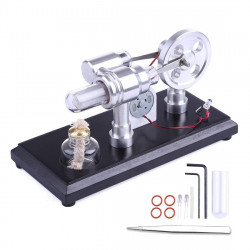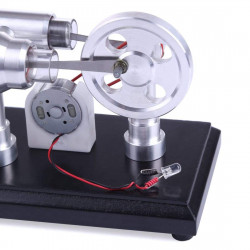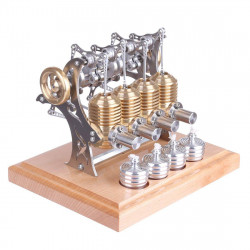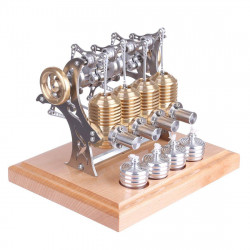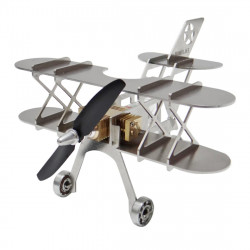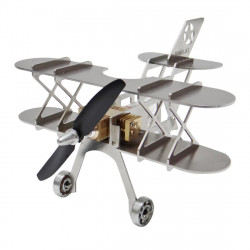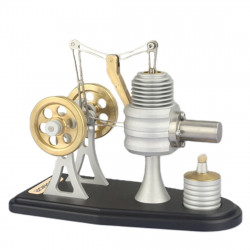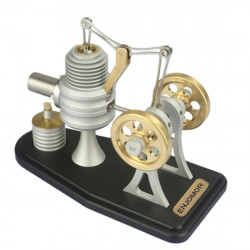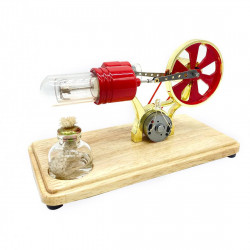
The greater the bypass ratio, the more fuel-efficient. What is the difference between a turbofan and a turbojet engine?
TECHING F135 Engine Metal DIY Mini Turbojet Engine Model
An internal and external ducted jet engine is another name for the so-called turbofan engine. This is an aircraft engine that powers a turbine with gas. Its primary characteristic is clear: The area of its first-stage fan blade is significantly larger than the turbine's. There are several jet engines.
The inner duct of the turbine engine is the passageway through which air flows, and the outer duct is the section through which the turbine propels the air through the first-stage supercharging fan blades. It goes without saying that supercharging and increasing the number of fan blades can combine the advantages of compressed air and propellers, enabling some of the air to be inhaled directly through the outside duct around the engine to boost thrust. When the internal and external ducts operate simultaneously, the result is the same as the dual thrust of a turboprop and a turbojet engine.
We must first discuss turboprop and turbojet engines in order to comprehend the unique benefits of turbofan engines.
We must first discuss turboprop and turbojet engines in order to comprehend the unique benefits of turbofan engines.
A conventional engine driven by a piston engine and a turboprop engine operate on essentially the same concept. The aircraft's forward propulsion is derived from the propeller's spin, which drives air flow. In general, they are comparable. The primary distinction is found in the power source that powers the propeller's central axis. A turboprop engine's gas turbine typically operates at a steady pace, but the piston-powered propeller varies in speed in response to the engine's speed. Diverse
The turbojet engine is more straightforward to comprehend. It produces thrust entirely by means of high-temperature, high-pressure gas flows. Despite its excellent operational efficiency and quick flight speed, it has poor economy and extremely high fuel consumption. From high-altitude supersonic aircraft to low-altitude and low-subsonic aircraft, turbojet engines are appropriate for a variety of navigational scenarios. The Mikulin-Tumansk Design Bureau's turbojet engine powered the former Soviet Union's MiG-25 high-altitude supersonic fighter. It once achieved a service ceiling record of 37,250 meters and a fighter speed record of Mach 3.3.
Returning to the subject, the turbofan engine that combines the two technical concepts is quite enormous, but only the central section is actually driven by a jet; fans drive the other sections. With this power distribution method, the unit, in addition to flying faster than a pure turboprop, uses less fuel per hour of thrust than a pure turbojet.
However, the boundary layer affects the turbofan engine when it flies at hypersonic speeds, which leads to inadequate thrust and weight at low pressures at high altitudes and supersonic speeds. Turbofan engines are, therefore, most suited for usage at flight speeds between 400 and 2,000 kilometres per hour or medium and low speeds up to Mach 1.6 supersonic speeds. As a result, faster turbofan engines currently power the majority of jet engines. Turbofan engines cannot be used with this model. A strong turbojet engine ought to be chosen instead.
The ratio of the amount of air that does not travel through the combustion chamber to the mass of air that does so per unit of time is known as the bypass ratio of a turbofan engine. The airplane depends more on jet propulsion, the lower the bypass ratio. The more the aircraft depends on the airflow going via the outer bypass to fly, the higher the bypass ratio. A turbojet engine is a turbofan engine with a zero bypass ratio. Low bypass ratios are a feature of both early turbofan engines and the turbofan engines seen in contemporary fighter jets. However, the majority of modern civil aviation aircraft have higher engine bypass ratios to conserve fuel. It is more extensive and typically occurs above 5, which is comparable to flying with a propeller. High bypass ratio turbofan engines are more suited for civil aircraft since they use less fuel, produce the same amount of thrust as turbojet engines, and operate considerably more quietly.
The Concorde, a former supersonic passenger aircraft, can be said to fly almost entirely using jets, but its operating costs are too high, and it has long been grounded. If you want to increase the flight speed, you need to replace civil aviation passenger aircraft with aircraft with smaller bypass ratios. This will increase fuel consumption and jet volume to obtain better propulsion effects, which will result in greater fuel consumption and louder noise.
In any event, turbofan engines with varying bypass ratios each have pros and cons, but there is no denying that the turbofan engine is the backbone of the human aviation sector.
